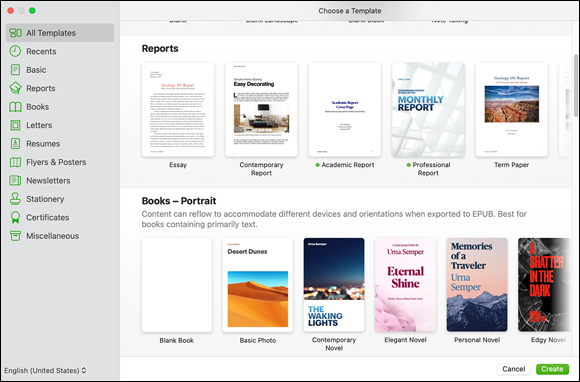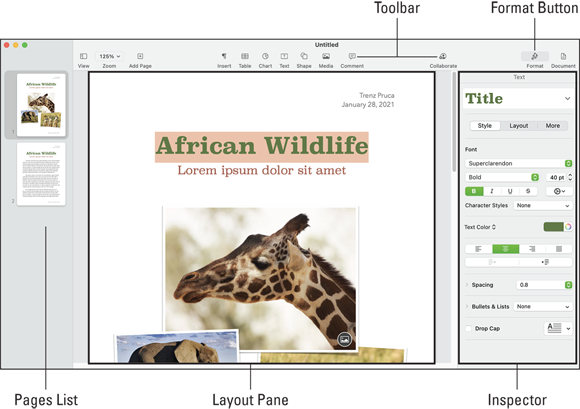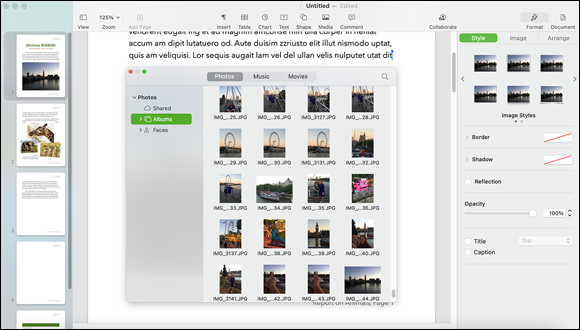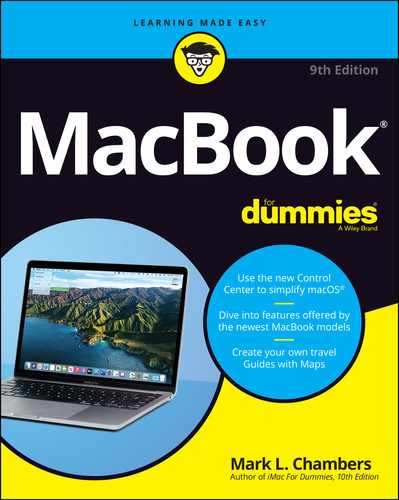Chapter 16
Desktop Publishing with Pages
IN THIS CHAPTER
![]() Creating, opening, and saving a Pages document
Creating, opening, and saving a Pages document
![]() Entering, editing, and formatting text
Entering, editing, and formatting text
![]() Inserting text, shapes, and graphics
Inserting text, shapes, and graphics
![]() Cutting, copying, and pasting
Cutting, copying, and pasting
![]() Setting document defaults
Setting document defaults
![]() Printing and sharing
Printing and sharing
What’s the difference between word processing and desktop publishing? In a nutshell, it’s in how you design your document. Most folks use a word processor like an old-fashioned typewriter, much like I’m using Microsoft Word right now. (Yawn.)
A desktop publishing application allows far more creativity in choosing where to place text, how to align graphics, and how to edit formats. I think desktop publishing is more visual and intuitive, allowing your imagination a free hand in creating a document.
In this chapter, I show you how to set your inner designer free from the tedious constraints of word processing. Whether you need a simple letter, a stunning brochure, or a multipage newsletter, Pages can handle the job with ease, and you’ll be surprised by how simple it is to use. Plus, Pages is a free download for any MacBook (and free Apple software is always A Good Thing).
Creating a New Pages Document
To create a new Pages document, follow these steps:
Click the Pages icon on the Dock.
If the Pages icon doesn’t appear on your Dock, click the Launchpad icon and then click the Pages icon (which looks like a document and pen). If you haven’t yet installed the three Apple productivity applications — Pages, Numbers, and Keynote — click the App Store icon on your Dock and download them for free!
Click the New Document button in the bottom-left corner of the Open dialog.
Pages displays the Choose a Template window, shown in Figure 16-1.
 You can also create a new Pages document at any time. Just choose File ⇒ New to display the Choose a Template window.
You can also create a new Pages document at any time. Just choose File ⇒ New to display the Choose a Template window.
FIGURE 16-1: Select a template from the Choose a Template window.
In the list on the left, click the type of document you want to create.
The thumbnails on the right are updated with templates that match your choice.
Click the template that most closely matches your needs.
To start with a blank page, choose the Blank template.
- Click the Choose button to open a new document that uses the template you selected.
Opening an Existing Pages Document
You can always open a Pages document from a Finder window, of course. Just double-click the document icon. You can also open a Pages document from within the program. Follow these steps:
- Launch Pages as described in the preceding section.
Press ⌘ +O to display the Open dialog.
The Open dialog operates much the same as a Finder window in Icon, List, or Column view mode. To open a document you’ve already saved in your iCloud Drive, click the Pages item below the iCloud heading in the Sidebar on the left side of the dialog and double-click the desired document thumbnail in the thumbnail display on the right side of the dialog. To open a document on your internal drive or network, click the desired location in the Open dialog sidebar. (If you’re into convenience, as I am, click one of the locations below the Favorites heading to jump to common folders such as Downloads or Documents!)
Click the desired drive in the Devices list on the left side of the dialog and then click folders and subfolders until you locate the Pages document.
You can also click the search box in the top-right corner of the Open dialog and type a portion of the document’s name or its contents.
 If you’re displaying the Preview column in Column view, you can hover the cursor over a document thumbnail and quickly flip through the pages by clicking the left and right arrows that appear. This “find” feature can help you identify a particular Pages document without even opening it.
If you’re displaying the Preview column in Column view, you can hover the cursor over a document thumbnail and quickly flip through the pages by clicking the left and right arrows that appear. This “find” feature can help you identify a particular Pages document without even opening it.Double-click the thumbnail (or filename) to load it.
If you want to open a Pages document you’ve edited in the recent past, things get even easier. Just choose File ⇒ Open Recent and you can open the document with a single click on the submenu that appears.
 Pages can open, edit, and save documents created in the Mac version of Microsoft Word.
Pages can open, edit, and save documents created in the Mac version of Microsoft Word.
Saving Your Work
Pages fully supports Big Sur’s Auto-Save feature, but you may feel the need to save your work manually after you finish a significant edit (or if you need to take a break while designing). If you’re editing a document that’s already been saved at least once, press ⌘ +S. A new version of the document is saved in its current location and you can continue with your work.
If you’re working on a new document that hasn’t been saved, follow these steps to save it:
- With the Pages document open, press ⌘ +S.
- Type a filename for your new document.
Open the Where pop-up menu and choose a location in which to save the document.
Note that Pages defaults to your iCloud Drive as the target location. This way, you can open and edit your Pages document on any Mac or iOS device that uses the same Apple ID. Alternatively, click the button sporting the down arrow to expand the Save As sheet. This sheet allows you to navigate to a different location on your hard drive or network or to create a new folder in which to store this Pages project.
- Click Save.
Touring the Pages Window
Before you dive into any real work, let me show you around the Pages window. You’ll find the following major components and controls, as shown in Figure 16-2:
- Pages list: This thumbnail list displays all the pages you’ve created within your document. (For a single-page document, of course, the Page list contains a single thumbnail.) You can switch instantly among different pages in your document by clicking the desired thumbnail in the list. If the list isn’t visible, click the View button at the left end of the Pages toolbar and then click Page Thumbnails.
- Layout pane: This section takes up most of the Pages window. It’s where you design and edit each page in your document.
- Toolbar: Yep, Pages has its own toolbar. It keeps all the most common application controls within easy, one-click reach.
- Inspector: This window extension allows you to quickly switch the appearance of selected paragraphs, characters, and lists (in Format mode) or to specify settings that affect the entire document (in Document mode). You can hide and display the Inspector from the View menu or the Format or Document buttons on the toolbar.

FIGURE 16-2: The major points of interest in the Pages window.
Entering and Editing Text
If you’ve used a modern word processing program, you’ll feel right at home typing within Pages. The bar-shaped text cursor, which looks like a capital letter I, indicates where the text you enter will appear in a Pages document. To enter text, simply begin typing. To edit existing text in your Pages document, select and highlight the text. As you type, Pages replaces the existing text. You can delete text by clicking and dragging across the characters to highlight them and then pressing Delete.
Using Text, Shapes, and Graphics Boxes
Within Pages, you’ll quickly learn that text, shapes, and graphics appear in boxes, which you can resize by clicking and dragging one of the handles that appear around the edges of the box. (Click the box to select it and then hover the cursor over one of the square handles. The handle changes to a double-headed arrow, indicating that Pages is ready to resize the box.)
You can also move a box, including all the stuff it contains, to another location within the Layout pane. Click in the center of the box and then drag the box to the desired spot. Note that Pages displays yellow alignment lines to help you align the box with other elements around it (or with regular divisions of the page, such as the vertical center of a poster or flyer).
The Three Amigos: Cut, Copy, and Paste
“Hang on, Mark. You’ve covered moving stuff, but what if you want to copy a block of text or a photo to a second location? Or how about cutting something from a document that’s open in another application?” Good questions. That’s when you can call on the power of the cut, copy, and paste features within Pages. The next few sections explain these actions.
Cutting stuff
Cutting selected text, shapes, or graphics removes them from your Pages document and places that material on your Clipboard. (Think of the Clipboard as a holding area for sections of existing text and graphics you want to manipulate.) To cut, select some material and then choose Edit ⇒ Cut or press ⌘ +X.
Copying text and images
When you copy text, shapes, or graphics, the original selection remains untouched and a copy of the selection is placed on the Clipboard. Select some material and choose Edit ⇒ Copy or press ⌘ +C. To copy selected items by dragging, hold down the Option key while you drag the items to their destination.
Pasting from the Clipboard
Wondering what you can do with the stuff that’s stored on the Clipboard? Pasting the contents of the Clipboard places the material at the current location of the insertion cursor.
To paste the Clipboard contents, click the insertion cursor at the location you want and choose Edit ⇒ Paste or press ⌘ +V.
Formatting Text the Easy Way
If you feel that some (or all) of the text in your Pages document needs a facelift, you can format that text any way you like. Formatting lets you change the color, font family, character size, and attributes as necessary.
After the text is selected, you can apply basic formatting in two ways:
- Use the Inspector. The Inspector appears on the right side of the Pages window (refer to Figure 16-2). The controls it displays vary according to the selection you’ve made. (Click the Format button on the right end of the toolbar, which looks like a tiny paintbrush, to display and hide the Inspector.) Click to select a font control to display a pop-up menu and then click your choice. Select a portion of text and open the Font Family pop-up menu to change the font family from vanilla Arial to something more daring, for example. You can also select characteristics, such as the text’s paragraph style, or choose italic or bold. In addition, the Inspector provides buttons for vertical and horizontal text alignment.
- Use the Format menu. Most controls displayed within the Format section of the Inspector are also available from the Format menu. Click Format and hover the cursor over the Font menu item, and you can apply boldface, italics, and underlining to the selected text. You can also make the text bigger or smaller. To change the alignment from the Format menu, click Format and hover the mouse cursor over the Text menu item.
Adding a Spiffy Table
In the world of word processing, a table is a grid that holds text, shapes, and graphics for easy comparison. You can create a custom table layout within Pages with a few simple clicks.
Follow these steps:
- Click the insertion cursor at the location where you want the table to appear.
Click the Table button on the Pages toolbar.
Pages displays thumbnail images of table styles. You have a selection of colors, and some tables even include highlighted rows and columns. Click the left and right icons to display different styles of thumbnails until you find the one that’s closest to the table you need.
Don’t worry if the style isn’t exactly right. You can always change the layout by selecting the table and displaying the Format Inspector, where you can fine-tune all sorts of font, color, grid, and border options.
Click the style thumbnail to insert the table.
If you need to change the number of rows or columns in your table, Pages makes it easy. To add or delete rows or columns directly from the table, select it and then click the row and column buttons that appear. (Each button bears two horizontal or vertical lines, as shown in Figure 16-3.)
Click within a cell in the table to enter text.
The table cell automatically resizes and wraps the text you enter to fit.
 You can paste material from the Clipboard into a table. See the earlier section “Pasting from the Clipboard” for details.
You can paste material from the Clipboard into a table. See the earlier section “Pasting from the Clipboard” for details.
Here are a few pointers on dressing up your table and making its data more attractive and readable:

FIGURE 16-3: Use Table controls to tweak your table.
Change the borders on a selected cell. Click the Format icon on the toolbar to open the Format Inspector, click the Cell tab, and then click the desired button in the Border section.
 Select a range of cells in a table by holding down Shift as you click. Hold down ⌘ and click to select multiple cells that aren’t contiguous.
Select a range of cells in a table by holding down Shift as you click. Hold down ⌘ and click to select multiple cells that aren’t contiguous.- Add a background color to selected cells, or fill them with an image for a background. Click the Cell tab, click the Fill section in the Inspector, and choose a type of background.
Adding Alluring Photos
You can choose one of two methods of adding a picture within your Pages document:
As a floating object: You place the image in a particular spot, and it doesn’t move even if you make changes to the text. To add a floating object, drag an image file from a Finder window and place it at the spot you want within your document. Alternatively, you can click the Media button on the toolbar, click Photos, navigate to the location where the file is saved, and click the image thumbnail. Figure 16-4 shows the Media Browser in action.
 Click the magnifying-glass icon to search for a specific item by using keywords.
Click the magnifying-glass icon to search for a specific item by using keywords.Note that a floating object (such as a shape or image) can be sent to the background, where text doesn’t wrap around it. To bring back a background object as a regular floating object, click the object to select it and then choose Arrange ⇒ Bring to Front. (More about background shapes in the next section.)
- As an inline object: The image flows with the surrounding text as you make layout changes. To add an inline object, hold down the ⌘ key as you drag an image file from a Finder window and place it where you want within your document. You can also click the Media toolbar button and then choose Photos to display the Media Browser. Navigate to the location where the file is saved, hold down the ⌘ key, and drag the image thumbnail to the spot where you want it in the document.

FIGURE 16-4: Hey, isn’t that the Pages Media Browser?
Adding a Background Shape
To add a shape (such as a rectangle or circle) as a background for your text, follow these steps:
- Click the insertion cursor in the location you want.
Click the Shape button on the Pages toolbar and choose a shape.
The shape appears in your document.
Click the center of the shape and drag it to a new spot.
Shapes can be resized or moved in the same manner as image boxes. See the preceding section.
Are You Sure about That Spelling?
Pages can check spelling as you type (the default setting) or after you complete your document. If you find automatic spell-checking to be distracting, you should pick the latter method.
To check spelling as you type, follow these steps:
- Click the Edit menu and hover the cursor over the Spelling and Grammar menu item.
Choose Check Spelling While Typing from the submenu that appears.
If a possible misspelling is found, Pages underlines the word with a red dashed line.
Right-click the word to choose a possible correct spelling from the list, or choose Ignore Spelling if it’s spelled correctly.
To turn off automatic spell-checking, click the Check Spelling While Typing menu item again to deselect it.
To check spelling manually, follow these steps:
- Click within the document to place the text insertion cursor where the spell check should begin.
- Click Edit, hover the cursor over the Spelling and Grammar menu item, and choose Check Document Now from the submenu that appears.
- Right-click any possible misspellings and choose the correct spelling or choose Ignore Spelling if the word is spelled correctly.
Set Your Font Defaults and Speed Things Up
If you typically use the same font and font sizes for your projects — for example, if your company has a standard font that’s used in all documents — you can save yourself time and trouble by setting those defaults for everything you create using the Blank template.
To set your Blank template font defaults, follow these steps:
- Click the Pages menu and choose Preferences.
- Click the Set Font and Size for New Basic Documents check box.
Choose a font family and default font size for body text from the sheet that appears.
 Note that you can also set Pages to create a new document using a template you specify. Click the Use Template radio button and then click the Change Template button to choose your default template.
Note that you can also set Pages to create a new document using a template you specify. Click the Use Template radio button and then click the Change Template button to choose your default template.- Click OK to save your changes; then click the Close button on the Preferences dialog.
Printing Your Pages Documents
Ready to start the presses? You can print your Pages document on real paper, of course, but don’t forget that you can also save a tree by creating an electronic PDF instead of a printout. You’ll find the PDF drop-down menu at the bottom of the standard Big Sur Print dialog; just click it and then click Save As PDF.
To print your Pages document on old-fashioned paper, follow these steps:
Within Pages, choose File ⇒ Print.
Pages displays the Print sheet.
- Click the Copies field and enter the number of copies you need.
- Select the pages to print:
- To print the entire document, select All.
- To print a range of selected pages, select the From radio button and enter the starting and ending pages.
Click the Print button to send the document to your printer.
 Note that it’s possible to embed a video or audio clip into a Pages document, and content like that is lost in a printed document!
Note that it’s possible to embed a video or audio clip into a Pages document, and content like that is lost in a printed document!
Sharing That Poster with Others
Besides printing (which is, after all, so very passé these days), you can choose to share your Pages document electronically via the Internet or your network:
Send a Copy: To send a copy of the actual document (which the recipient can open in Pages on his or her own Mac or iOS device), choose Share from the Pages menu and hover the cursor over the Send a Copy item. You can send the document via Mail, Notes, or Messages, or you can make it available through AirDrop (if the recipient is within range of your MacBook’s Wi-Fi signal).
 If you decide to send your Pages document as an email attachment, don’t forget that most Internet service providers have a maximum message size. If your document is too large, your mail server probably will reject it.
If you decide to send your Pages document as an email attachment, don’t forget that most Internet service providers have a maximum message size. If your document is too large, your mail server probably will reject it.Export: You’re not limited to sharing over that Internet thing! Pages can also export your work directly to your drive in one of six formats: a PDF file, a Word document, an ePub file (for use with electronic book apps such as iBooks), a document that’s compatible with the previous version of Pages, a Rich Text Format document, and even plain text. (Remember when everything was in plain text?) Choose File ⇒ Export To and pick your format; Pages displays any options you can set for that format. When you’re ready, click Next and select the location where Pages should save the file. Click Export and then sit back while your favorite desktop publishing application does all the work.
 If the recipient of your document doesn’t need to edit your work, I recommend creating a PDF file, which keeps your document as close as possible to the way it appears in Pages.
If the recipient of your document doesn’t need to edit your work, I recommend creating a PDF file, which keeps your document as close as possible to the way it appears in Pages.

 You must paste the contents before you cut or copy again to avoid losing what’s on the Clipboard.
You must paste the contents before you cut or copy again to avoid losing what’s on the Clipboard.